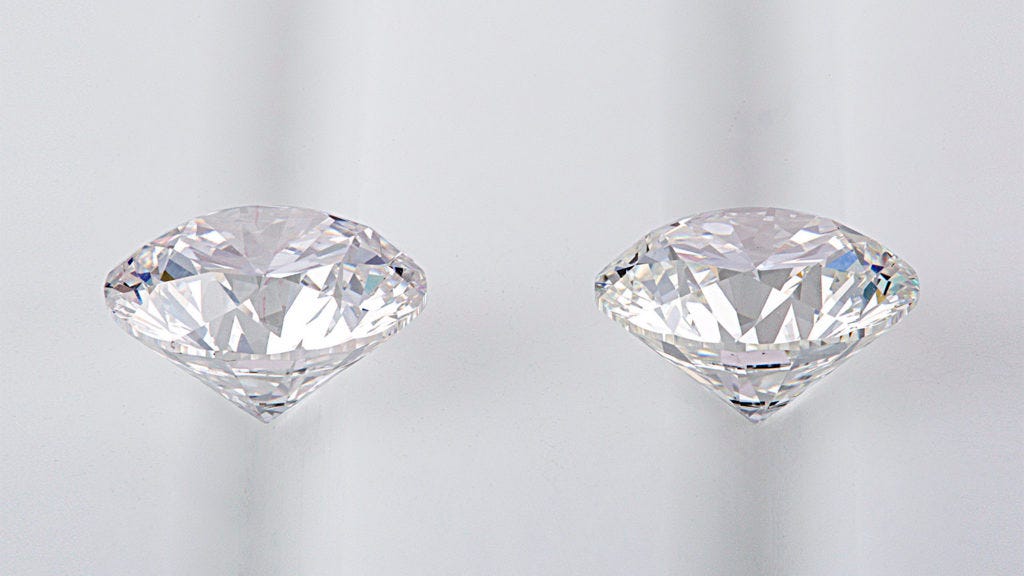Diamonds have long been symbols of love, luxury, and status. Traditionally, natural diamonds, formed over billions of years under immense pressure and heat within the Earth’s mantle, have dominated the market. However, advancements in technology have led to the creation of lab-grown diamonds, offering consumers a viable alternative. This comprehensive comparison explores the cost, quality, and value of lab-grown versus natural diamonds to help you make an informed decision.
Cost
Natural diamonds are inherently expensive due to the lengthy and complex process required for their formation and extraction. These diamonds form over billions of years deep within the Earth, and mining them is labor-intensive and costly. The rarity of high-quality, large natural diamonds further increases their value. The extensive supply chain, from mining to market, involves many intermediaries, each adding their markup, which drives prices even higher.
In contrast, lab-grown diamonds are created in controlled environments using methods such as High-Pressure High-Temperature (HPHT) or Chemical Vapor Deposition (CVD). These methods replicate the natural conditions under which diamonds form but do so in a matter of weeks. The production process for lab-grown diamonds is more efficient and less labor-intensive, resulting in significantly lower costs. Generally, lab-grown diamonds can be 30-40% cheaper than natural diamonds of the same size and quality, making them an attractive option for budget-conscious consumers.
Quality
The quality of a diamond, whether natural or lab-grown, is assessed using the four Cs: carat, cut, color, and clarity. Natural diamonds often have unique inclusions and slight color variations due to their natural formation process. This uniqueness can add to their charm, but it also means that finding high-quality natural diamonds can be more challenging and expensive.
Lab-grown diamonds, being created in controlled environments, are virtually identical to natural diamonds in terms of their physical, chemical, and optical properties. They tend to have fewer inclusions and more consistent color, resulting in higher clarity and overall quality. Advanced technology allows for precise cuts, enhancing the brilliance and sparkle of lab-grown diamonds. While some diamond enthusiasts believe the imperfections in natural diamonds add character, lab-grown diamonds offer a more consistent and predictable quality.
Value
The value of a diamond is influenced by its resale potential and investment viability. Natural diamonds typically hold their value better over time and are often seen as a long-term investment. Their rarity and historical significance contribute to their lasting appeal and market demand. High-value transactions, such as auctions and resale through established jewelers, generally favor natural diamonds, and certain exceptional natural diamonds can even appreciate over time.
Lab-grown diamonds, on the other hand, currently have a lower resale value compared to natural diamonds. This is partly due to their newer presence in the market and the perception of being less “authentic.” While they are gaining popularity, lab-grown diamonds are not yet as widely accepted in high-value transactions, and their value may depreciate faster due to the increasing ease and decreasing cost of production.
Environmental and Ethical Considerations
The environmental and ethical implications of diamond purchases are significant for many consumers. Natural diamond mining can have severe environmental consequences, including habitat destruction and pollution. Additionally, the diamond mining industry has faced scrutiny over human rights abuses and the issue of conflict diamonds, which fund armed conflict and exploitation.
Lab-grown diamonds offer a more sustainable and ethical alternative. They have a smaller environmental footprint, requiring fewer resources and causing less ecological damage. Lab-grown diamonds are also free from the ethical concerns associated with mining, providing a more humane option for socially conscious consumers. These advantages can add considerable value to lab-grown diamonds for those who prioritize environmental and ethical considerations.
When comparing lab-grown and natural diamonds, the choice ultimately depends on individual preferences and priorities. Natural diamonds offer a sense of rarity, tradition, and long-term value, making them a preferred choice for those seeking a timeless and potentially appreciating asset. Lab-grown diamonds provide a more affordable, sustainable, and ethically sound option without compromising on quality, appealing to modern, socially conscious consumers. By understanding the differences in cost, quality, and value, you can make an informed decision that aligns with your needs and values, ensuring that the diamond you choose is perfect for you.
